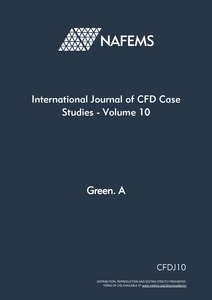
NAFEMS International Journal of CFD Case Studies
Volume 10, March 2013
ISSN 1462-236X
https://doi.org/10.59972/52ge55zl
The papers in this 10th volume of the Journal offer a wide range of CFD application topics each presenting comparisons with experiment as validation.
Technical textile fabrics have many uses, one such use, is in the paper making industry. In the paper by Farber et al water needs to flow through a textile with specific properties, requiring much trial testing of the fabric structure. A technique of “weaving” single cylindrical filaments together is used to create a small sample of a commercial fabric. The sample is used to simulate an experimental set up where water flows through the fabric and velocities are compared to Magnetic Resonance Imaging results.
Friction stir welding of metals is a new technology with equipment design largely relying on empirical data from welding performance tests. The process is highly non-linear comprising complex heat transfer, metal plastic deformation and flow. Simulating the welding tool at the plunge, dwell and traverse stages allows a better understanding of the process and parameters. The paper by Mackenzie et al calculates transient temperature distributions and metal flow visualizations in the welding process.
Lifeboats launched from ships and offshore platforms must avoid overloading the occupants and vessel hull. A computational method using overlapping grids, to simplify the handling of lifeboat motion and specification of initial and boundary conditions, is used in the paper by Mørch et al to calculate vessel accelerations and pressures. The achieved accuracy in numerical simulations is comparable to the accuracy of experiments and provides a new design evaluation method.
Sanding systems are used to prevent a tram skidding on the rails, keeping sand used to a minimum. Simulating a sand-air mixture requires modelling the behaviour of the sand particles on the surface of the rails. A stochastic sub-model described in the paper by Möller et al, tuned using in-house experiment results, led to an improved design of the sanding device and sand jet which were later tested.
Water is inevitable in aircraft fuel tanks and aircraft movements create waves or “slosh” the fuel and water interface. Removing the water requires the positioning of scavenge pick-up locations to be optimised. The paper by Hylands et al uses CFD to simulate the dynamic motion of two liquids in a rectangular tank and compared to flow visualisation and pressure data results from a sloshing test rig.
Three of the papers mention the desire to make CFD the preferred method of analysis, the experimental approach is variously described as laborious, time-consuming, costly and requiring many optimisation tests. This is an old debate – “CFD replaces the wind tunnel” was mooted thirty years ago and we are still waiting! Most CFD practitioners realise that both are currently required for real engineering design - the challenge is to understand where each technique may augment the other.
Contents
Computational Fluid Dynamics Simulations ofthe Complex Geometry of a Technical Textile K Farber, J Jasper, M Märtin, M Schmitt, S Krick, P Farber, J Leisen1 and HW Beckham1
Institut für Modellbildung und Hochleistungsrechnen der Hochschule Niederrhein, Krefeld, Germany
1Georgia Institute of Technology, School of Polymer, Textile & Fiber Engineering, Atlanta, USA | pp. 5-17 |
Multi-physics Models for Friction Stir Welding Simulation D Mackenzie, H Li and R Hamilton
Department of Mechanical Engineering, University of Strathclyde, Glasgow G1 1XJ, UK | pp. 19-30 |
CFD-Supported Design of Lifeboats HJ Mørch1, Milovan Perić2, Jasmin Röper2 and Eberhard Schreck2
1CFD Marin, Tvedestrand, Norway
2CD-adapco, Nürnberg, Germany | pp. 31-42 |
Optimization of a Sanding System for a Tramway Car by Numerical Simulation of the Sand-Air Two-Phase Flow S Möller1, D Langmayr1,2, G Brenn3 and P Krieg4
1Competence Center - The Virtual Vehicle (ViF), Graz, Austria
2now at: ANSYS Germany GmbH, Otterfing
3Institute of Fluid Mechanics and Heat Transfer (ISW), TU Graz
4KNORR-BREMSE GmbH, Mödling | pp. 43-56 |
Water in Fuel Sloshing for Aircraft Fuel Tanks G Hylands1,2, CA Toomer1 and J K-W Lam2
1University of the West of England, UK
2Airbus Operations Ltd., UK | pp. 57-68 |
Further Details
Each of these case studies has been reviewed by members of the CFD working group to ensure that the paper includes:
- A full description of the industrial relevance of the case study and why it has been performed;
- A full description of related experimental or analytical data, together with statements as to their quality and accuracy;
- A description of the CFD model which allows the interested reader to fully appreciate how it simulates the given industrial case;
- The CFD model is detailed covering the flow physics, geometry, meshing, boundary conditions, fluid properties and the solving processes;
- A set of results are presented and discussed to facilitate the reader’s appreciation that the work has been performed well and to a high standard.
Any Journal is only as good as the papers it publishes, so the Journal needs contributors who see the importance and benefit of having their work published and used by fellow engineers. Engineers are by nature supportive of colleagues, and authoring a case study paper for the Journal gives senior engineers an opportunity to pass on their hard won knowledge and experience, and in some sense “set the standard” of practice in the field. The Journal publishes CFD case study papers, i.e. investigations, simulations and validation exercises in accordance with CFD best practice guidelines. Original papers covering either traditional CFD, multi-phase flows, combustion and topics such as parallel computing, immersed boundary methods, DNS, LES, FSI, LBM, DEM, etc. are welcomed, book reviews and letters to the Editor are also acceptable.
Potential contributors are welcome to contact the editor, Professor Don McGlinchey at cfd.journal@nafems.org to discuss any aspect of the Journal and the process, from authoring to review to publication. Further details are available here.



